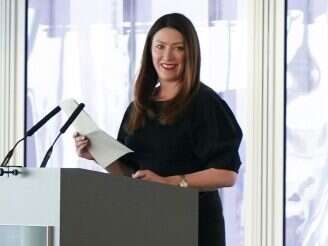
Sun editor Victoria Newton has said having more female Fleet Street editors makes it easier for women journalists to “feel supported”.
But she acknowledged there is still “work to be done” to make newsrooms more diverse and representative.
Some 42% (eight out of 19) of the UK’s national daily and Sunday print newspapers are now edited by women – up from 21% in 2019.
Newton (pictured) was appointed to lead The Sun, and continue overseeing The Sun on Sunday, in February 2020.
A week earlier, former Times deputy editor Emma Tucker was appointed to lead The Sunday Times – in the same month that Roula Khalaf became the first female editor of The Financial Times.
Kath Viner has been editor-in-chief of The Guardian and Observer since 2015 and Mirror editor-in-chief Alison Phillips has been in post since 2018. She was joined by Gemma Aldridge at the Sunday Mirror and Sunday People in March 2021.
Other prominent female editors include Deborah Arthurs at Metro Online, Gill Smith of The Scottish Sun, Rachel Corp at ITV News and Esme Wren at Channel 4 News. Internationally, Reuters editor-in-chief Alessandra Galloni and Washington Post executive editor Sally Buzbee were both appointed last year.
Introducing a panel held at News UK’s London headquarters on Monday night ahead of International Women’s Day, Newton said: “Journalism is also increasingly a better workplace for women, making up 42% of national newspaper editors including here at The Sun, Sunday Times, Financial Times, Mirror, Sunday Mirror and Guardian. I can’t tell you how much that has changed since I started 20 years ago.
“More women in more leadership positions makes it easier for younger journalists to feel supported in the newsroom and it also means our female readers are better represented in the stories that we tell. Of course there’s still work to be done to make our newsrooms even more diverse and representative…”
By contrast only 28% of regional newspaper editors are women, according to the Fawcett Society.
It also found that 12% of national newspaper political editors are women compared to 40% of broadcast political editors
By Press Gazette’s calculation, only three female journalists (on the FT, Daily Express and The Times) had bylines on Tuesday’s front pages – 13% of the total. Several of the lead stories were about Ukraine, where the majority of newspaper correspondents are men – although broadcasters have many well-known female journalists posted in the country such as Sky’s Alex Crawford and Deborah Haynes, and the BBC’s Lyse Doucet and Sarah Rainsford.
Newton praised the work of journalists in Ukraine: “I speak from experience when I say it [journalism] can be an incredibly rewarding and exciting job, and there has never been a bigger need for a free press than right now.
“The brave journalists currently reporting from the conflict in Ukraine mean we know exactly what’s happening on the ground as well as the real human consequences of war.”
The Reuters Institute for the Study of Journalism said the UK was one of three markets along with the US and Spain (among 12 markets examined) in which at least half of top editors newly appointed in the past year were women.
The new study looked at 240 online and offline publications with the biggest audiences, and said only 21% of the 179 top editors at these brands were women. This compares to the 40% of the journalists across the 12 markets who are women.
By this methodology looking only at the brands with the biggest reach, excluding the FT for example and including online-only brands, the RISJ said women made up 38% of the UK’s top editors, up from 27% last year.
The report said: “While there is a weak positive correlation between the percentage of women working as journalists and the percentage of women among top editors, there continues to be a lower proportion of women in top roles than women in the profession as a whole.”
Gill Smith, editor of The Scottish Sun, became the newspaper's first female editor exactly a year ago.
She wrote in Tuesday's paper: "I didn’t set out to shatter any glass ceilings or be a pioneer — I just wanted to be editor of the biggest and best paper in the country."My appointment was the culmination of years of hard work and some sacrifices. Fortunately, I work for a company which recognises achievements, regardless of gender, and embraces women in senior positions."Unfortunately, too many women do still have to make sacrifices, make a choice between career and family or juggle too many balls to make it happen."
Smith added that the industry has "come a long way" since she started, when a "thick skin" was needed, and that although more female journalists are still needed "the tide has at least changed".
"I would now like to think young female journalists will see that progress has been made and realise everything is possible if everyone continues to challenge gender stereotypes."
Picture: News UK
Email pged@pressgazette.co.uk to point out mistakes, provide story tips or send in a letter for publication on our "Letters Page" blog
